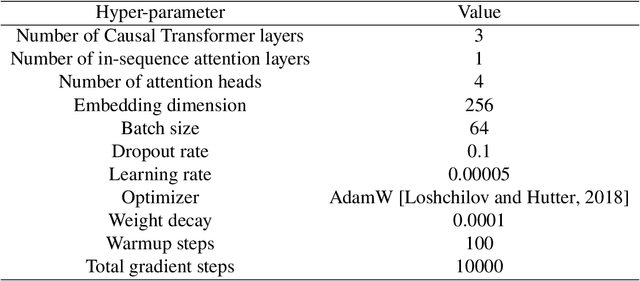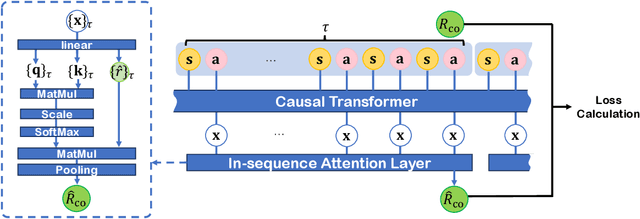Qiyu Wu
VIRTUE: Visual-Interactive Text-Image Universal Embedder
Oct 01, 2025Abstract:Multimodal representation learning models have demonstrated successful operation across complex tasks, and the integration of vision-language models (VLMs) has further enabled embedding models with instruction-following capabilities. However, existing embedding models lack visual-interactive capabilities to specify regions of interest from users (e.g., point, bounding box, mask), which have been explored in generative models to broaden their human-interactive applicability. Equipping embedding models with visual interactions not only would unlock new applications with localized grounding of user intent, which remains unexplored, but also enable the models to learn entity-level information within images to complement their global representations for conventional embedding tasks. In this paper, we propose a novel Visual-InteRactive Text-Image Universal Embedder (VIRTUE) that extends the capabilities of the segmentation model and the vision-language model to the realm of representation learning. In VIRTUE, the segmentation model can process visual prompts that pinpoint specific regions within an image, thereby enabling the embedder to handle complex and ambiguous scenarios more precisely. To evaluate the visual-interaction ability of VIRTUE, we introduce a large-scale Segmentation-and-Scene Caption Retrieval (SCaR) benchmark comprising 1M samples that aims to retrieve the text caption by jointly considering the entity with a specific object and image scene. VIRTUE consistently achieves a state-of-the-art performance with significant improvements across 36 universal MMEB (3.1%-8.5%) and five visual-interactive SCaR (15.2%-20.3%) tasks.
From Chaos to Order: The Atomic Reasoner Framework for Fine-grained Reasoning in Large Language Models
Mar 20, 2025



Abstract:Recent advances in large language models (LLMs) have shown remarkable progress, yet their capacity for logical ``slow-thinking'' reasoning persists as a critical research frontier. Current inference scaling paradigms suffer from two fundamental constraints: fragmented thought flows compromising logical coherence, and intensively computational complexity that escalates with search space dimensions. To overcome these limitations, we present \textbf{Atomic Reasoner} (\textbf{AR}), a cognitive inference strategy that enables fine-grained reasoning through systematic atomic-level operations. AR decomposes the reasoning process into atomic cognitive units, employing a cognitive routing mechanism to dynamically construct reasoning representations and orchestrate inference pathways. This systematic methodology implements stepwise, structured cognition, which ensures logical coherence while significantly reducing cognitive load, effectively simulating the cognitive patterns observed in human deep thinking processes. Extensive experimental results demonstrate AR's superior reasoning capabilities without the computational burden of exhaustive solution searches, particularly excelling in linguistic logic puzzles. These findings substantiate AR's effectiveness in enhancing LLMs' capacity for robust, long-sequence logical reasoning and deliberation.
Cross-Modal Learning for Music-to-Music-Video Description Generation
Mar 14, 2025Abstract:Music-to-music-video generation is a challenging task due to the intrinsic differences between the music and video modalities. The advent of powerful text-to-video diffusion models has opened a promising pathway for music-video (MV) generation by first addressing the music-to-MV description task and subsequently leveraging these models for video generation. In this study, we focus on the MV description generation task and propose a comprehensive pipeline encompassing training data construction and multimodal model fine-tuning. We fine-tune existing pre-trained multimodal models on our newly constructed music-to-MV description dataset based on the Music4All dataset, which integrates both musical and visual information. Our experimental results demonstrate that music representations can be effectively mapped to textual domains, enabling the generation of meaningful MV description directly from music inputs. We also identify key components in the dataset construction pipeline that critically impact the quality of MV description and highlight specific musical attributes that warrant greater focus for improved MV description generation.
Joint Fusion and Encoding: Advancing Multimodal Retrieval from the Ground Up
Feb 27, 2025Abstract:Information retrieval is indispensable for today's Internet applications, yet traditional semantic matching techniques often fall short in capturing the fine-grained cross-modal interactions required for complex queries. Although late-fusion two-tower architectures attempt to bridge this gap by independently encoding visual and textual data before merging them at a high level, they frequently overlook the subtle interplay essential for comprehensive understanding. In this work, we rigorously assess these limitations and introduce a unified retrieval framework that fuses visual and textual cues from the ground up, enabling early cross-modal interactions for enhancing context interpretation. Through a two-stage training process--comprising post-training adaptation followed by instruction tuning--we adapt MLLMs as retrievers using a simple one-tower architecture. Our approach outperforms conventional methods across diverse retrieval scenarios, particularly when processing complex multi-modal inputs. Notably, the joint fusion encoder yields greater improvements on tasks that require modality fusion compared to those that do not, underscoring the transformative potential of early integration strategies and pointing toward a promising direction for contextually aware and effective information retrieval.
DeepResonance: Enhancing Multimodal Music Understanding via Music-centric Multi-way Instruction Tuning
Feb 18, 2025Abstract:Recent advancements in music large language models (LLMs) have significantly improved music understanding tasks, which involve the model's ability to analyze and interpret various musical elements. These improvements primarily focused on integrating both music and text inputs. However, the potential of incorporating additional modalities such as images, videos and textual music features to enhance music understanding remains unexplored. To bridge this gap, we propose DeepResonance, a multimodal music understanding LLM fine-tuned via multi-way instruction tuning with multi-way aligned music, text, image, and video data. To this end, we construct Music4way-MI2T, Music4way-MV2T, and Music4way-Any2T, three 4-way training and evaluation datasets designed to enable DeepResonance to integrate both visual and textual music feature content. We also introduce multi-sampled ImageBind embeddings and a pre-alignment Transformer to enhance modality fusion prior to input into text LLMs, tailoring DeepResonance for multi-way instruction tuning. Our model achieves state-of-the-art performances across six music understanding tasks, highlighting the benefits of the auxiliary modalities and the structural superiority of DeepResonance. We plan to open-source the models and the newly constructed datasets.
Beyond Simple Sum of Delayed Rewards: Non-Markovian Reward Modeling for Reinforcement Learning
Oct 26, 2024



Abstract:Reinforcement Learning (RL) empowers agents to acquire various skills by learning from reward signals. Unfortunately, designing high-quality instance-level rewards often demands significant effort. An emerging alternative, RL with delayed reward, focuses on learning from rewards presented periodically, which can be obtained from human evaluators assessing the agent's performance over sequences of behaviors. However, traditional methods in this domain assume the existence of underlying Markovian rewards and that the observed delayed reward is simply the sum of instance-level rewards, both of which often do not align well with real-world scenarios. In this paper, we introduce the problem of RL from Composite Delayed Reward (RLCoDe), which generalizes traditional RL from delayed rewards by eliminating the strong assumption. We suggest that the delayed reward may arise from a more complex structure reflecting the overall contribution of the sequence. To address this problem, we present a framework for modeling composite delayed rewards, using a weighted sum of non-Markovian components to capture the different contributions of individual steps. Building on this framework, we propose Composite Delayed Reward Transformer (CoDeTr), which incorporates a specialized in-sequence attention mechanism to effectively model these contributions. We conduct experiments on challenging locomotion tasks where the agent receives delayed rewards computed from composite functions of observable step rewards. The experimental results indicate that CoDeTr consistently outperforms baseline methods across evaluated metrics. Additionally, we demonstrate that it effectively identifies the most significant time steps within the sequence and accurately predicts rewards that closely reflect the environment feedback.
Word Alignment as Preference for Machine Translation
May 15, 2024Abstract:The problem of hallucination and omission, a long-standing problem in machine translation (MT), is more pronounced when a large language model (LLM) is used in MT because an LLM itself is susceptible to these phenomena. In this work, we mitigate the problem in an LLM-based MT model by guiding it to better word alignment. We first study the correlation between word alignment and the phenomena of hallucination and omission in MT. Then we propose to utilize word alignment as preference to optimize the LLM-based MT model. The preference data are constructed by selecting chosen and rejected translations from multiple MT tools. Subsequently, direct preference optimization is used to optimize the LLM-based model towards the preference signal. Given the absence of evaluators specifically designed for hallucination and omission in MT, we further propose selecting hard instances and utilizing GPT-4 to directly evaluate the performance of the models in mitigating these issues. We verify the rationality of these designed evaluation methods by experiments, followed by extensive results demonstrating the effectiveness of word alignment-based preference optimization to mitigate hallucination and omission.
Enhancing Cross-lingual Sentence Embedding for Low-resource Languages with Word Alignment
Apr 03, 2024Abstract:The field of cross-lingual sentence embeddings has recently experienced significant advancements, but research concerning low-resource languages has lagged due to the scarcity of parallel corpora. This paper shows that cross-lingual word representation in low-resource languages is notably under-aligned with that in high-resource languages in current models. To address this, we introduce a novel framework that explicitly aligns words between English and eight low-resource languages, utilizing off-the-shelf word alignment models. This framework incorporates three primary training objectives: aligned word prediction and word translation ranking, along with the widely used translation ranking. We evaluate our approach through experiments on the bitext retrieval task, which demonstrate substantial improvements on sentence embeddings in low-resource languages. In addition, the competitive performance of the proposed model across a broader range of tasks in high-resource languages underscores its practicality.
Generating, Reconstructing, and Representing Discrete and Continuous Data: Generalized Diffusion with Learnable Encoding-Decoding
Feb 29, 2024Abstract:The vast applications of deep generative models are anchored in three core capabilities -- generating new instances, reconstructing inputs, and learning compact representations -- across various data types, such as discrete text/protein sequences and continuous images. Existing model families, like Variational Autoencoders (VAEs), Generative Adversarial Networks (GANs), autoregressive models, and diffusion models, generally excel in specific capabilities and data types but fall short in others. We introduce generalized diffusion with learnable encoder-decoder (DiLED), that seamlessly integrates the core capabilities for broad applicability and enhanced performance. DiLED generalizes the Gaussian noising-denoising in standard diffusion by introducing parameterized encoding-decoding. Crucially, DiLED is compatible with the well-established diffusion model objective and training recipes, allowing effective learning of the encoder-decoder parameters jointly with diffusion. By choosing appropriate encoder/decoder (e.g., large language models), DiLED naturally applies to different data types. Extensive experiments on text, proteins, and images demonstrate DiLED's flexibility to handle diverse data and tasks and its strong improvement over various existing models.
Reinforcement Learning from Bagged Reward: A Transformer-based Approach for Instance-Level Reward Redistribution
Feb 06, 2024Abstract:In reinforcement Learning (RL), an instant reward signal is generated for each action of the agent, such that the agent learns to maximize the cumulative reward to obtain the optimal policy. However, in many real-world applications, the instant reward signals are not obtainable by the agent. Instead, the learner only obtains rewards at the ends of bags, where a bag is defined as a partial sequence of a complete trajectory. In this situation, the learner has to face the significant difficulty of exploring the unknown instant rewards in the bags, which could not be addressed by existing approaches, including those trajectory-based approaches that consider only complete trajectories and ignore the inner reward distributions. To formally study this situation, we introduce a novel RL setting termed Reinforcement Learning from Bagged Rewards (RLBR), where only the bagged rewards of sequences can be obtained. We provide the theoretical study to establish the connection between RLBR and standard RL in Markov Decision Processes (MDPs). To effectively explore the reward distributions within the bagged rewards, we propose a Transformer-based reward model, the Reward Bag Transformer (RBT), which uses the self-attention mechanism for interpreting the contextual nuances and temporal dependencies within each bag. Extensive experimental analyses demonstrate the superiority of our method, particularly in its ability to mimic the original MDP's reward distribution, highlighting its proficiency in contextual understanding and adaptability to environmental dynamics.
 Add to Chrome
Add to Chrome Add to Firefox
Add to Firefox Add to Edge
Add to Edge